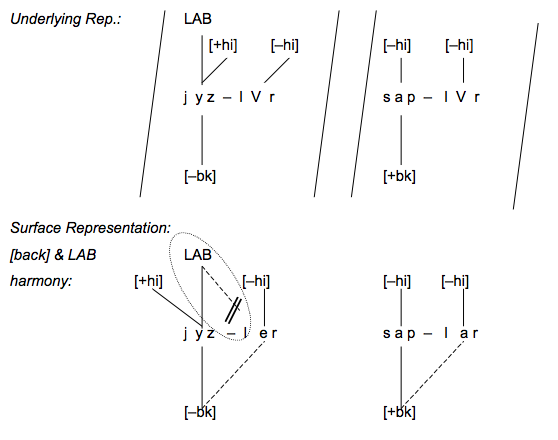Phonology: case studies
By Scott Myers and Megan Crowhurst
Department of Linguistics at the University of Texas
Back harmony with nonhigh suffix vowels
Nonhigh suffix vowels are also affected by vowel harmony, but they behave differently from the high vowels we have just seen. The forms in (10) and (11) show that the nominative nonplural and plural forms differ such that in the plural forms, the root is followed by a sequence -ler or -lar. We can reasonably assume that these are variants (allomorphs) of a morpheme that marks plural nouns.
As in the case of the genitive suffix, which variant of the plural morpheme surfaces is determined by context. The forms in (10) show that when the preceding vowel is a front vowel [i, e, y], or [-ø], we find -ler with a front vowel in the plural.
| (10) |
| Last Root V | Nom | Gen | Gloss | ||
|---|---|---|---|---|---|
| [i] | ip | ipin | 'rope' | ||
| tjilci | tjilcin | 'fox' | |||
| [e] | el | elin | 'hand' | ||
| cep | cepin | 'cap' | |||
| [y] | jyz | jyzyn | 'face' | ||
| ɟyt͡ʃ | ɟyd͡ʒyn | 'power' | |||
| [ø] | cøj | cøjyn | 'village' | ||
| ɟøz | ɟøzyn | 'eye' |
On the other hand, in (11) we find the allomorph -lar, with a back vowel, when the preceding vowel is also back, one of the set [ɨ, a, u, o].
| (11) |
| Last Root V | Nom | Gen | Gloss | ||
|---|---|---|---|---|---|
| [ɨ] | kɨz | kɨzɨn | 'girl' | ||
| arɨ | arɨn | 'bee' | |||
| [a] | t͡ʃan | t͡ʃanɨn | 'bell' | ||
| sap | sapɨn | 'stalk' | |||
| [u] | pul | pulun | 'stamp' | ||
| boru | borun | 'pipe' | |||
| [o] | son | sonun | 'end' | ||
| jol | jolun | 'road' |
The [-high] suffix vowels are like the [+high] suffix vowels in two ways: in both cases, the suffix vowel is [+back] or [-back] depending on the backness of the preceding vowel, and second, vowel height does not change. However, unlike the genitive suffix, roundness doesn't vary in the plural morpheme. (This is why the plural suffix has only two allomorphs as opposed to four.) The generalization in (12) pulls together our observations in a slightly different way.
| (12) | Turkish vowel harmony. | |
| a. | Suffix vowels undergo an unrestricted process of back harmony such that the suffix vowel agrees with the backness of the preceding vowel regardless of the latter vowel's other properties. | |
| b. | Suffix vowels are also subject to a more restricted process of labial harmony conditioned by height: a [+high] suffix vowel agrees in rounding with the preceding vowel, whereas a [-high] suffix vowel is always nonround. | |
As in the case of [+high] suffix vowels, we can't tell which allophone ([a] or [e]) is the basic allophone, because the context in which each appears can be stated in equally simple terms:
| (13) | Allophonic distribution of [-high] suffix vowels: | |
| [a] | after a back vowel, [ɨ, a, u, o] | |
| [e] | after a front vowel, [i, e, y, ø] | |
As before, we can adopt the assumption that suffix vowels are unspecified for [back], and are assigned a value for [back] through assimilation to the preceding vowel. An informal statement of Back/LAB harmony with nonhigh vowels is given in (14).
| (14) | Back/Labial Harmony with [-high] suffix vowels: A [-high] suffix vowel assimilates the backness of the preceding vowel. [-high]suffix vowels do not assimilate the Labial properties of the preceding vowel. |
Now, we should consider whether it is necessary to write new rules to account for the nonhigh vowel cases, or whether it should be possible to handle all cases, whether they involve high or nonhigh vowels, with a single set of rules. It would be desirable to extend the rules we already have, if we can, because this would make possible a more parsimonious account (that is - we aim to do more with as little as possible). In fact, we can generalize our analysis of back harmony by simply eliminating the feature [+high] from the rule in (8a). The final version of Back Harmony is shown in (15).
| (15) | Back Harmony (final version) | |
 |
||
Our rule of LABIAL should remain as it was originally stated in (8b), because LAB harmony does not apply to nonhigh vowels. The results of applying Back Harmony and LABIAL Harmony to the underlying representations for jyzler and saplar are shown in (16). The diagram for the surface representation in (16) is meant to suggest that Labial harmony is blocked (indicated by the double line in the surface representation for jyzler) when the target vowel is [-high].
| (16) | Autosegmental model: | |
 |
||